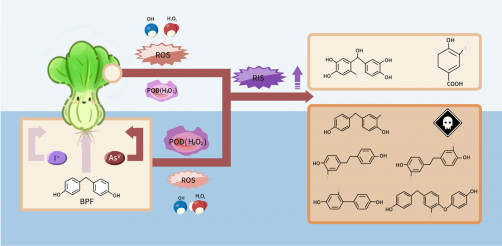Science
Researchers Uncover Arsenic’s Role in Enhancing Iodination in Vegetables

A recent study by researchers at Shandong University has revealed significant findings regarding arsenic contamination in vegetables and its effects on iodination processes. Titled “Risks and Mechanistic Insights Into Arsenic-Enhanced Iodination of Bisphenol F in Brassica chinensis L.,” the research was published in Frontiers of Environmental Science & Engineering, Volume 19, Issue 6.
Arsenic (As) contamination in agricultural products poses serious ecological and health risks, sparking public concern globally. While previous studies have examined arsenic accumulation and transformation in plants, the specific effects of arsenic on the iodination of phenolic pollutants, such as bisphenol F (BPF), remain largely unexplored. This study aims to fill that knowledge gap.
To conduct the research, the team exposed Brassica chinensis L. to hydroponic solutions comprising sodium hydrogen arsenate heptahydrate (As(V)) at concentrations ranging from 0 to 100 μmol/L, BPF at a concentration of 3 mg/L, and iodide ions at 40 μmol/L. These conditions were designed to mimic environmentally relevant scenarios.
The researchers found that As(V) significantly enhances the iodination of BPF. This enhancement occurs through the increased production of reactive oxygen species, including hydrogen peroxide (H2O2) and hydroxyl radicals (•OH). Additionally, the study noted an elevation in peroxidase (POD) activity, which was confirmed through transcriptomic analysis.
As the concentration of As(V) increased, the diversity and concentration of iodinated BPF products in the roots of the plants exhibited a clear dose-dependent increase. Correspondingly, the variety of iodinated products found in the leaves also rose, demonstrating a direct relationship between arsenic levels and iodination.
To identify the specific substitution sites of iodide atoms in the BPF molecules, the research employed Gaussian calculations and mass spectrometry. These methods revealed the number of iodide atoms incorporated into the BPF structure, further elucidating the chemical transformations occurring in the presence of arsenic.
The study also assessed the toxicity of the iodinated BPF products using the Toxicity Estimation Software Tool (T·E·S·T) and the Ecological Structure-Activity Relationships (ECOSAR) model. The findings indicated that the toxicity of iodinated BPF products increased in plants following the addition of As(V). This was corroborated by measurements of HepG2 cell viability and lactate dehydrogenase (LDH) activity in the cell culture medium.
Overall, the research highlights the compounded risks associated with arsenic and bisphenol contamination. It underscores arsenic’s role in enhancing the iodination process and the subsequent increase in toxicity of the resulting compounds in plants.
For more detailed information, the full study is available at https://journal.hep.com.cn/fese/EN/10.1007/s11783-025-2003-x. This research not only contributes to our understanding of environmental hazards but also raises awareness about the potential health implications of consuming contaminated vegetables.
-

 Science1 week ago
Science1 week agoResearchers Challenge 200-Year-Old Physics Principle with Atomic Engines
-

 Politics1 week ago
Politics1 week agoNHP Foundation Secures Land for 158 Affordable Apartments in Denver
-

 Health1 week ago
Health1 week agoNeuroscientist Advocates for Flag Football Until Age 14
-

 Health1 week ago
Health1 week agoFDA Launches Fast-Track Review for Nine Innovative Therapies
-

 Lifestyle1 week ago
Lifestyle1 week agoLongtime Friends Face Heartbreak After Loss and Isolation
-

 Politics1 week ago
Politics1 week agoIsraeli Air Strikes in Lebanon Kill One, Wound Seven Amid Tensions
-

 World1 week ago
World1 week agoTroops to Enjoy Buffalo Chicken, Thai Curry in 2026 MREs
-

 Business1 week ago
Business1 week agoMaine Housing Inventory Surges to Post-Pandemic High
-

 World1 week ago
World1 week agoGlobal Military Spending: Air Forces Ranked by Budget and Capability
-

 Politics1 week ago
Politics1 week agoMassachusetts Lawmakers Resist Audit After Voter Mandate
-

 Top Stories1 week ago
Top Stories1 week agoUnforgettable Moments: The Best Victoria’s Secret Performances
-

 Business1 week ago
Business1 week agoSpirit Airlines Cuts Workforce with Furloughs for 365 Pilots









